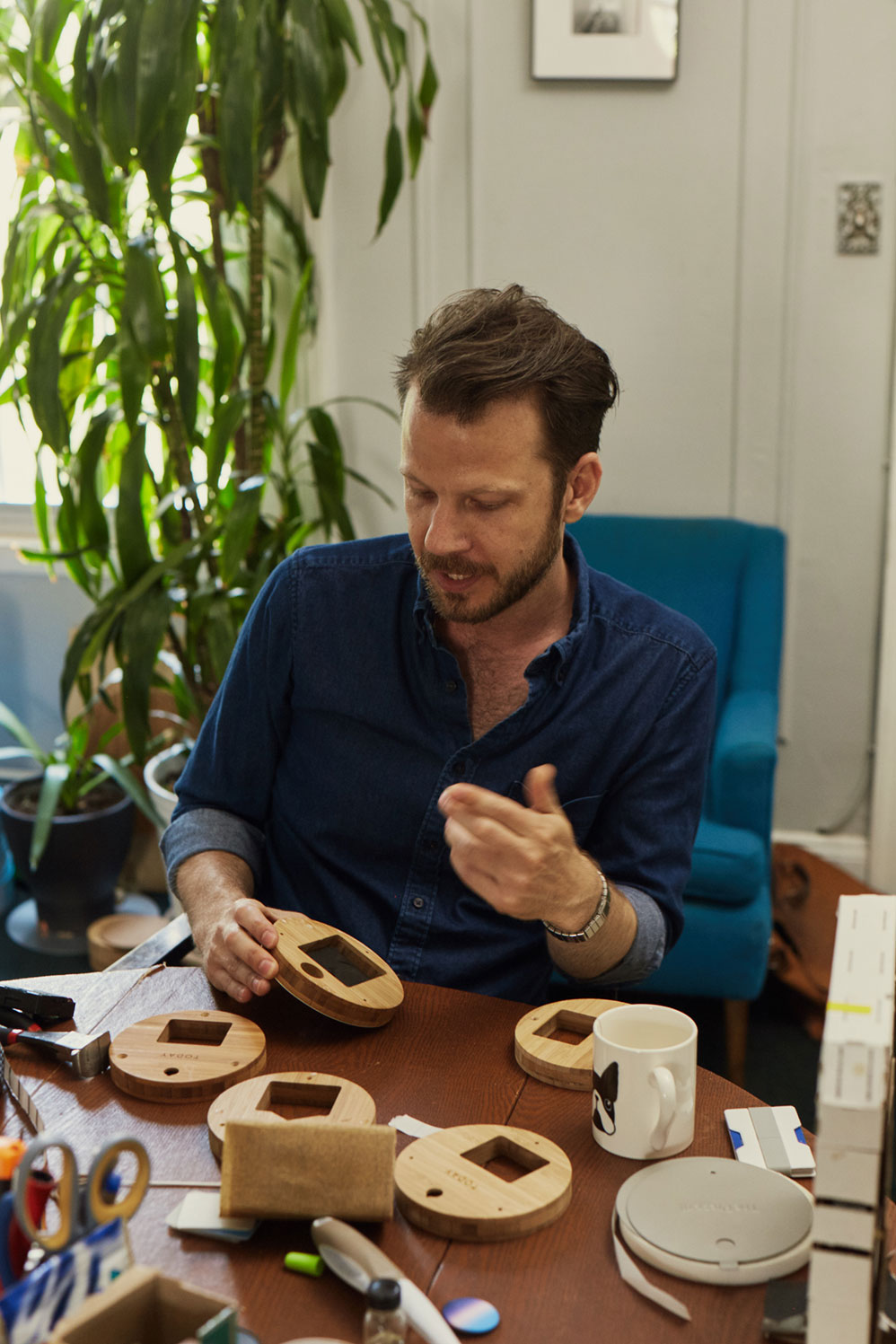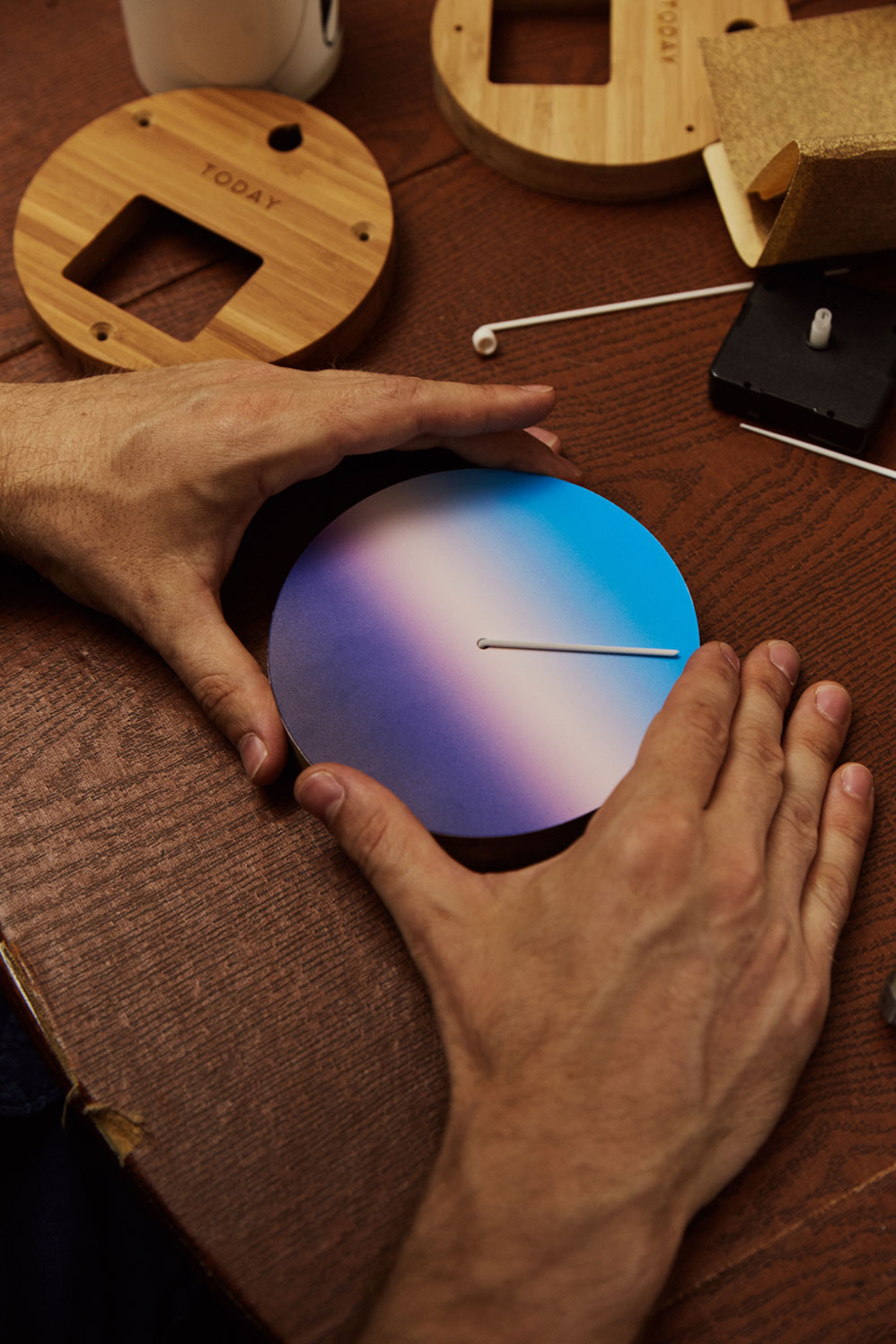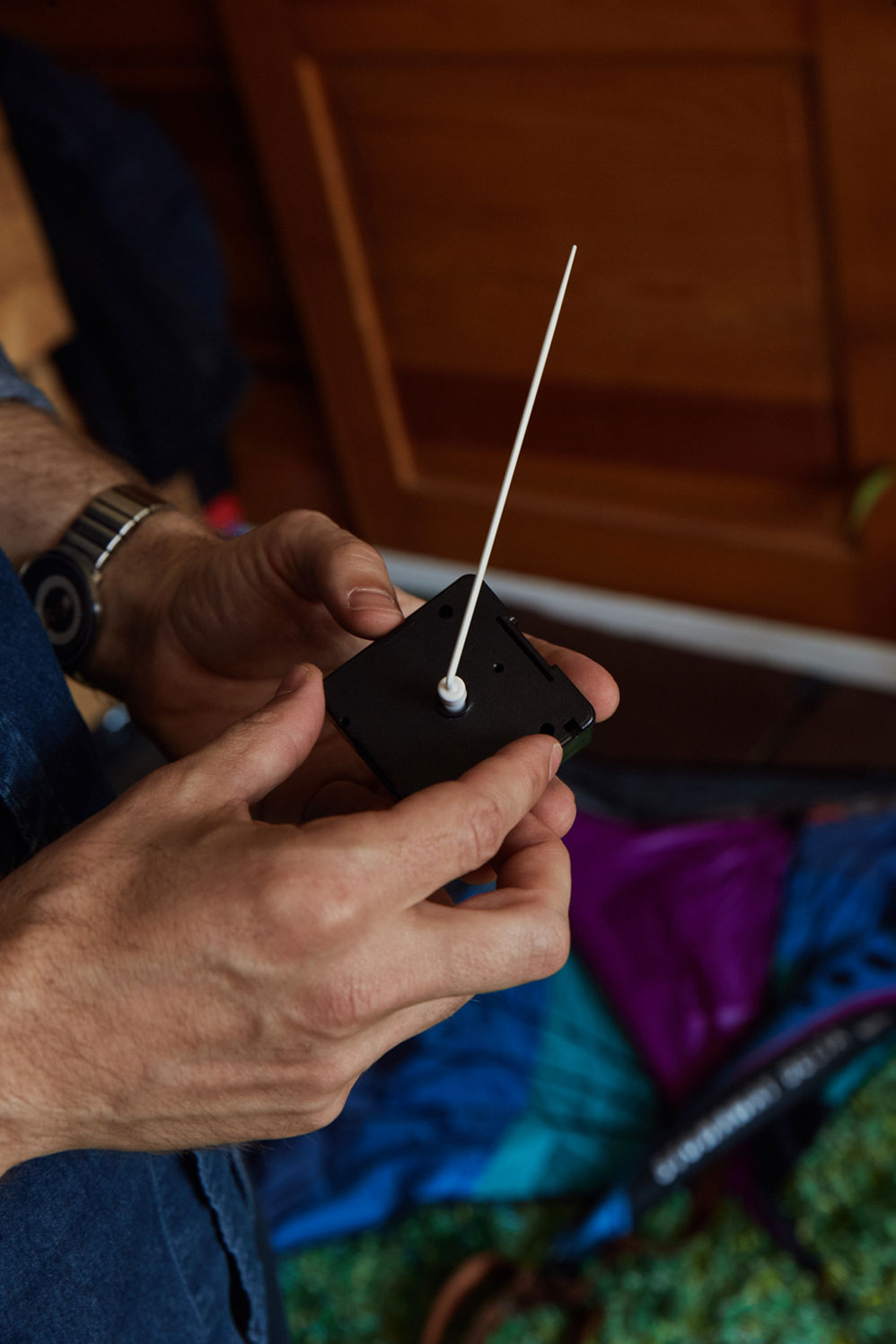Sometimes, on sunny, windy days, Scott Thrift walks to the cemetery near his apartment and flies a kite. There are no power lines. No trace of urban pandemonium. No people but those under his feet. Incidentally, he says, theirs is the company he seeks.
“There’s something about being in a cemetery and thinking about all the troubles and the conflicts in the world, and realizing that these people would likely give anything to have ten seconds of life to take a deep breath, to fly a kite,” he says. “And when I’m there, feeling the wind, I also feel those people whispering to me to go for it—to take advantage of life and make the most of it. Because of that, I really believe that cemeteries aren’t made for the dead. They’re made for the living.”
A filmmaker turned timepiece designer, Scott is best known for The Present, a rainbow-hued clock that completes one full revolution per year. His newest work, Today—recently funded on Kickstarter by over 1,400 backers—completes its cycle every 24 hours. Both were designed to inspire a new method of relating to the passage of time—much of which is rooted in the concept of living utterly and unreservedly in the now.
“Past and future are a matter of perspective,” he says. “In a very real way, the only thing there is, is the eternal present. I hope my work speaks to this as I am convinced that it’s the path to a robust experience of life. Growing up, I only read about time machines that would send you into the future or place you in the past. Little did I know that I would become someone who makes time machines that transport you to the here and now. You have to start somewhere. Why not here? Why not now?”
This portrait is part of our ongoing collaboration with ZEIT Online. Head over to ZEIT Magazin Online to flick through more unseen images from our story with Scott.




-
You’ve worked as a filmmaker, and also as co-founder of a production company called m ssin g p eces. Tell us how you landed on timepiece design.
The process involved with being a filmmaker, I think, was really the genesis of all of this. Flying around the world, interviewing people and filming things, you’re essentially capturing time. Then, when you bring home the raw footage, you’re compressing it in order to craft the perfect moment—it’s all about trying to compress time into something beautiful.
Then there are other influences. I’ve had the privilege of traveling to so many places over the course of my life, and I’ve learned that what people want the most—regardless of where they’re from— is more time. Time to be alive, to enjoy, to have a thrilling experience of life. As a civilization on a planet in space, we share that—and it’s important to me to be creating things that bind people together in ways that transcend the nationality, age, race, religion. So there’s a larger ambition here, other than making cool clocks.
-
Your first clock, The Present, measured time by the season. What inspired the thinking behind your newest creation, Today?
It was actually living with The Present that inspired this new idea. The Present completes one revolution every year—it moves very slowly. Wherever its hand is pointed at any given moment is the present. And the beauty of it is, wherever you are in the world, that hand is in the same place. Essentially, it’s Earth time.
Clocks haven’t changed in 200 years. Our whole lives, you, me and everyone we know have been looking at time in a way that was popularized during the Industrial Revolution. Experiencing time by living with The Present—that is, from the perspective of a year—made me want to have something that was a little bit more practical, but that retained the poetic, abstract component of what I had already made.






“When you change the way you measure time, you can change the way you measure your life.”
-
What was most important in the design of Today, visually speaking?
The most important thing that I kept coming back to is the beauty of the horizon. It’s something that’s inspired artists throughout history. It has an element of hope to it. That quickly became the focus. What happens is, you look at the clock briefly and you register first and foremost that horizon line. It really gives you a much more simplified vision of time than you’re used to. And not only is that a relief, but it actually makes you feel as if you have more time. It simultaneously challenges your expectations and gives you a sort of padding that I feel we all really want and need. You don’t get that with a clock that’s black and white with three hands, one of which is moving by the second.
It’s easy to think every day that something is going to be different—that we’re going to be able to catch up, that we’ll finish our emails or get in touch with that friend we haven’t spoken to in forever. But we never seem to have the time. Ultimately, I think that has everything to do with how we measure it. When you change the way you measure time, you can change the way you measure your life.
-
You’ve said before, “I never imagined myself as someone who introduces new scales of time. But I can’t imagine being involved in anything more urgent, meaningful and rewarding.” How does the concept of your clocks—and the process of clock making— speak to you personally?
Well, it had been a real challenge to make the original clock, and I had a moment where I thought, should I keep doing this? Then, three to six months after I shipped out The Present, I started getting unsolicited letters from people about the impact it was having. It was that feedback that has really helped me understand that this is something that I really need to push for—and the main reason is that I’m doing something that allows me to give back. I don’t feel like I’m taking. I would eventually like to have a child, but I’m not ready for that right now, so this is what I’m giving to the world.
On another note, when I look at the present day as if it were the past—when I fast-forward 100 years and look back on 2016—I really feel like I’m doing the only thing I need be doing, and it’s something people will appreciate in time. I can’t imagine that 100 years from now, people are going to be using a clock that wouldn’t look out of place in 1816. Clocks like Today and The Present are going to be much more common and are going to help people connect with the natural world in ways we’ve turned our backs to over the past 200 years.






“I’ve had the privilege of having access to culture in a way that’s helped me see a couple of leaps ahead, and I’m acting on it.”
-
As someone who is so rooted in the present, do you ever plan ahead? And if so, what is ahead for you?
I’ve always had trouble managing any sort of calendar. I have to admit that. I think that in some ways, it’s impossible for us to think further ahead than the day after tomorrow. But then again, I plan ahead on a huge scale. I feel like I’m thinking about what’s vital for the human race over the next 100 to 200 years. I’ve had the privilege of having access to culture in a way that’s helped me see a couple of leaps ahead, and I’m acting on it. I truly feel I’m doing exactly what I’m supposed to be doing—in the right place, at the right time.





Thank you for your valuable time, Scott. It was a pleasure discovering what makes you tick. Visit Scott’s Kickstarter to learn more about Today and get your hands on one of Scott’s clocks here.
Photography:Collin Hughes
Interview & Text:Shoko Wanger

